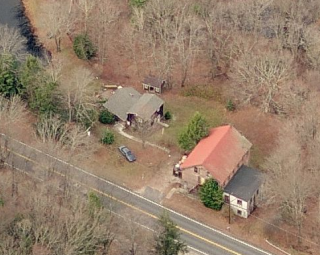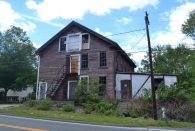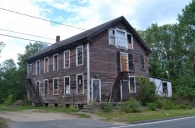Mill Record Stafford
RETURN TO ‘FIND MILLS’Disclaimer: Content for these properties was compiled in 2014-2017 from a variety of sources and is subject to change. Updates are occasionally made under Property Information, however the Connecticut Trust for Historic Preservation (dba Preservation Connecticut) makes no representation or warranty that the information is complete or up-to-date.
- Complex Name (Common)
- West Stafford Button Shop
- Complex Name (Historic)
-
- West Stafford Button Shop
- Address or Location
- 15 Crystal Lake Road, West Stafford, Stafford
- County
- Tolland
- Historic Designation
- Associated Mill Community
- n/a

- Historic Information
Companies Associated w/Complex
- Charles Waldner Company 1922-1942
- Greaves Engine Shop ca. 1900
- Henry A. Buck Gun Manufactory ca. 1880s
- J.R. Whiton Warp and Twine Manufactory ca. 1850-ca. 1880s
- Mullen Shoddy Mill ca. 1880s
- Pacific Pearl Button Company 1946-1957
- Sturtevant Wood Shop ca. 1910
Use (Historic)
Largest Documented Workforce
Unknown.
Historic Narrative
The former West Stafford Button Shop had a diverse array of occupants during its roughly 100 years in operation as a manufacturing plant. The earliest documented use of the building appears to have been as a cotton warp and twine mill established by J.R. Whiton during the 1850s and continued through the 1870s. During the early 1880s, the factory was converted for use as a shoddy mill by the Mullen family, and then was acquired by Henry Buck for use as a gun manufactory. Buck later shifted to the production of a variety of highly polished molded cement products, namely paperweights. Around 1900, the mill was occupied by the gasoline engine plant run by Henry and Norman Greaves, and then passed to Francis Sturtevant, who used it as a woodworking shop. Button manufacturing began in the mill in 1922, when a Czechoslovakian immigrant by the name of John Cyril Soukop moved his pearl button factory from New York City. Soukop’s firm went by the name of the Charles Waldner Button Company, and this continued to operate in West Stafford until 1942 when the Second World War interrupted the flow of pearl shells from the Pacific and forced the closure of the business. Soukop was called back to work in 1946 by Abraham Rubin, whose New York City-based Pacific Pearl Button Company purchased the mill and reactivated it with Soukop serving as general manager. As pearl shells became increasingly expensive by the late-1940s, the Pacific Pearl Button Company switched to plastics. The company experienced much success working with this medium and new machinery was purchased and its workforce tripled during the early-1950s. By that time the company was led by Abraham Rubin, president; Gilbery Rubin, vice-president; Edith Rubin, treasurer; and Joe Bernat, general manager. In 1957, however, the company moved operations back to New York City so as to be closer to its distribution hub.
- Architectural Information
Number of Existing Buildings
Two (2) adjoining blocks.
Dates of Construction
ca. 1850, ca. 1950
Architect
n/a
Builder
n/a
Building Type
Architectural Description
The former West Stafford Button Shop is comprised of two adjoining blocks on the west side of Crystal Lake Road, northeast of a mill pond and roughly 600’ southwest of Crystal Lake Road’s intersection with Conklin Road. The main and original portion of the factory is a two-and-a-half-story, 35’ x 48’ frame manufacturing building. The structure is of vernacular styling and is three bays wide and six bays deep. The building has a stone foundation, wood clapboard sheathing, wood corner and rakeboards, and a front-facing gable roof. Fenestration consists of six-over-six double-hung frame sash. Three pass-through entries are located on the building’s east (front) elevation, two of these found on the ground level, and another on the second floor accessed via a metal fire stair. A paired loading door with hoist beam above is located in the southern gable end, this flanked on each side by a window opening. A fourth pass-through entry to the main block is found on the south (side) elevation, this accessed via a metal fire stair. A one-story concrete block ells with exposed basement level adjoins the original building’s north (side) elevation. This measures 22’ x 36’ and has a shed roof. A frame pass-through door is located on its east (front) elevation and six-over-six double-hung wood windows can be found on the basement and first-floor levels of the east, north, and west sides of the addition.
Exterior Material(s)
Structural System(s)
Roof Form
Roof Material
Power Source
Condition
Deteriorated
Condition Notes
The factory is in deteriorated condition. The clapboard siding appears to have gone unpainted for some time and many of the windows are poorly maintained or missing. The structural condition is unknown.
- Property Information
-
Specific Location
One 1.2-acre parcel (15 Crystal Lake Road) on the west side of Crystal Lake Road, northeast of a mill pond and roughly 600’ southwest of Crystal Lake Road’s intersection with Conklin Road.
Adjacent To
Exterior Visible from Public Road?
Yes
Parcel ID / Assessor Record Link
- 45/ / 58 / Link →
Acreage
1.2
Use (Present)
- Sources
-
Form Completed By
Lucas A. Karmazinas
Date
02/24/2015
Bibliography
- Map of Tolland County, Wm. C. Eaton & H.C. Osborn, 1857.
- Atlas of Tolland County, O.W. Gray, 1869.
- Sanborn Map Company, 1884, 1892, 1897, 1911, 1921, 1930, 1943.
- Aerial Survey of Connecticut, 1934, 1965.
- Birdseye View of Stafford Springs, Conn., O.H. Bailey & Co., 1878.
- List of Connecticut Manufacturers, 1922, 1924, 1930, 1932.
- Directory of Connecticut State Manufacturers, 1936, 1939.
- Industrial Directory of Connecticut, 1947.
- Register of War Production Facilities in Connecticut, 1951.
- Hartford Courant, 1942, 1946, 1957.
- History of the Town of Stafford, Stafford Library Assoc., 1935.
- Stafford, Connecticut, 250th Anniversary, 1969.
- Stafford Illustrated, Young, William, 1895.
- Town of Stafford HRI, Gibbs, James, 1993.
- Representative View(s)Click on image to view full file






